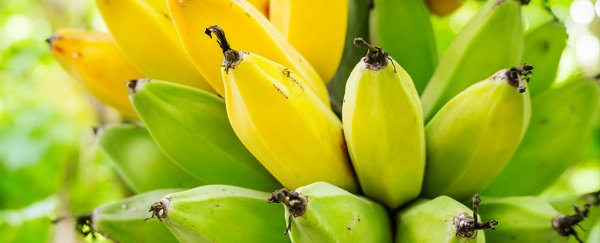While some people like their bananas green, others love a mushy brown banana. But is there really a difference between the two?
Surprisingly yes – and you could be picking the ripeness of the banana you eat based on your health.
This revelation started with a photo on Instagram, shared by @fitness_meals, that shows a circle of a whole bunch of bananas at basically every level of ripeness. Each banana has a number from one to 15, with one being the most underripe and 15 being the most overripe.
The caption says: "What's your choice? I would do between 5 and 6."
Instagram users immediately began debating in the comments. Most picked eight through 10, but several said four through seven.
The Daily Mail spoke to Rhiannon Lambert, a UK-based nutritionist who wrote the book Re-Nourish: A Simple Way to Eat Well, to see whether one type of banana was better than the others.
Lambert said that while bananas are always an excellent source of potassium and other nutrients, there are different benefits to eating them at different ripenesses, depending on your health.
Underripe bananas have less sugar
If you have diabetes, you should consider eating bananas that are more underripe rather than overripe. This is because as a banana ripens, the starch begins to turn to sugar.
Lambert told the Daily Mail: "Research suggests that in underripe bananas, starch constitutes 80-90 percent of the carbohydrate content, which, as the banana ripens, changes into free sugars. Therefore, people who suffer with diabetes are advised to eat bananas that are not overly ripe as not to spike their blood sugar too much."
Overripe bananas are easier to digest
Slightly overripe bananas, on the other hand, are probably a better option for anyone who has trouble digesting the food.
The Verge reported that a greener banana has more "resistant starch," which humans can't digest but can be good for you, as "good gut bacteria" like it.
Nicholas Gillitt, the vice president of nutrition research and director of the Dole Nutrition Institute, told the outlet that "it's the kind of starchy material that bacteria look to feed on."
Lambert echoed that sentiment, telling the Daily Mail, "When the resistant starch changes to simple sugar, a banana ripens, and studies have suggested that more ripe bananas are easier to digest for the average person."
A fully brown banana is full of antioxidants
An article on Spoon University says that when a banana is almost or fully all brown, basically all the starch has broken down into sugar – they're sweeter, which is why people often use mushy bananas to bake with – and chlorophyll has taken a new form.
"This breakdown of chlorophyll is the reason why antioxidant levels increase as bananas age," the article says. "So a fully brown banana is an antioxidant powerhouse."
When it comes down to it, any choice of banana is a good one
At the end of the day, though, nutritionists seem to agree that you can eat your banana however you want and still get the most out of the fruit.
The nutritional content doesn't change depending on how ripe the banana is. The only thing that really changes is the taste and how your body processes the sugar.
So the kind of banana you should eat is pretty much just based on preference.
This article was originally published by Business Insider.
More from Business Insider:
